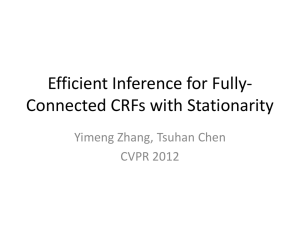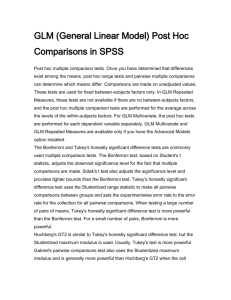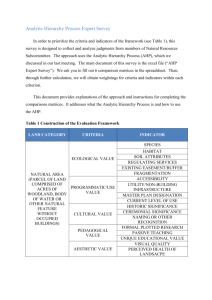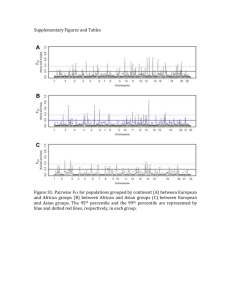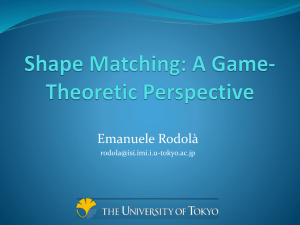On the Value of Pairwise Constraints in Classification and Consistency
advertisement
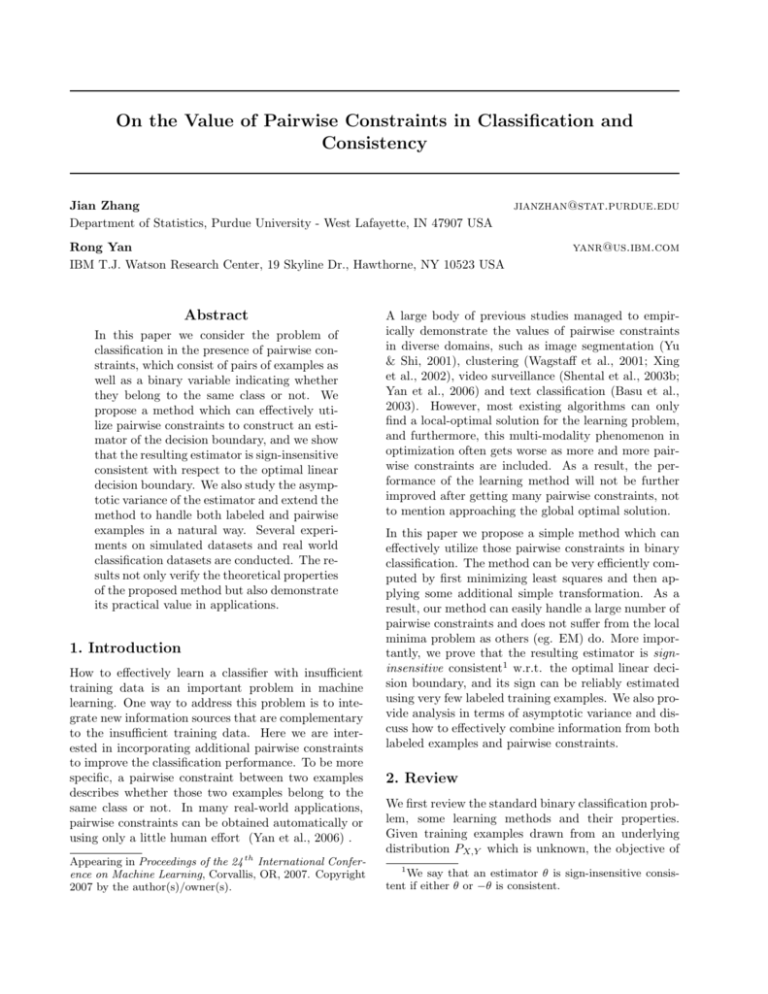
On the Value of Pairwise Constraints in Classification and
Consistency
Jian Zhang
Department of Statistics, Purdue University - West Lafayette, IN 47907 USA
Rong Yan
IBM T.J. Watson Research Center, 19 Skyline Dr., Hawthorne, NY 10523 USA
Abstract
In this paper we consider the problem of
classification in the presence of pairwise constraints, which consist of pairs of examples as
well as a binary variable indicating whether
they belong to the same class or not. We
propose a method which can effectively utilize pairwise constraints to construct an estimator of the decision boundary, and we show
that the resulting estimator is sign-insensitive
consistent with respect to the optimal linear
decision boundary. We also study the asymptotic variance of the estimator and extend the
method to handle both labeled and pairwise
examples in a natural way. Several experiments on simulated datasets and real world
classification datasets are conducted. The results not only verify the theoretical properties
of the proposed method but also demonstrate
its practical value in applications.
1. Introduction
How to effectively learn a classifier with insufficient
training data is an important problem in machine
learning. One way to address this problem is to integrate new information sources that are complementary
to the insufficient training data. Here we are interested in incorporating additional pairwise constraints
to improve the classification performance. To be more
specific, a pairwise constraint between two examples
describes whether those two examples belong to the
same class or not. In many real-world applications,
pairwise constraints can be obtained automatically or
using only a little human effort (Yan et al., 2006) .
Appearing in Proceedings of the 24 th International Conference on Machine Learning, Corvallis, OR, 2007. Copyright
2007 by the author(s)/owner(s).
jianzhan@stat.purdue.edu
yanr@us.ibm.com
A large body of previous studies managed to empirically demonstrate the values of pairwise constraints
in diverse domains, such as image segmentation (Yu
& Shi, 2001), clustering (Wagstaff et al., 2001; Xing
et al., 2002), video surveillance (Shental et al., 2003b;
Yan et al., 2006) and text classification (Basu et al.,
2003). However, most existing algorithms can only
find a local-optimal solution for the learning problem,
and furthermore, this multi-modality phenomenon in
optimization often gets worse as more and more pairwise constraints are included. As a result, the performance of the learning method will not be further
improved after getting many pairwise constraints, not
to mention approaching the global optimal solution.
In this paper we propose a simple method which can
effectively utilize those pairwise constraints in binary
classification. The method can be very efficiently computed by first minimizing least squares and then applying some additional simple transformation. As a
result, our method can easily handle a large number of
pairwise constraints and does not suffer from the local
minima problem as others (eg. EM) do. More importantly, we prove that the resulting estimator is signinsensitive consistent1 w.r.t. the optimal linear decision boundary, and its sign can be reliably estimated
using very few labeled training examples. We also provide analysis in terms of asymptotic variance and discuss how to effectively combine information from both
labeled examples and pairwise constraints.
2. Review
We first review the standard binary classification problem, some learning methods and their properties.
Given training examples drawn from an underlying
distribution PX,Y which is unknown, the objective of
1
We say that an estimator θ is sign-insensitive consistent if either θ or −θ is consistent.
On the Value of Pairwise Constraints in Classification and Consistency
classification is to find a predictor h(x) : Rp 7→ R so
that the following generalization error is made as small
as possible:
R = EX,Y [I(sign(h(X)) 6= Y )],
(1)
where I(.) is the set indicator function and EX,Y is
used to denote the expectation w.r.t. the distribution
PX,Y .
Given a set of i.i.d. samples (x1 , y1 ), . . . , (xm , ym )
drawn from PX,Y where xi ∈ Rp and yi ∈ {±1}, the
following criterion is often used in practice to find a
predictor in a pre-specified hypothesis space H:
m
1 X
L(h(xj ), yj ) + λm Ω(h) , (2)
ĥ = arg min
h∈H m
j=1
where L(., .) : R×{±1} 7→ R+ is some convex loss function, Ω(h) measures the complexity of the predictor h,
and λm ≥ 0 is used to control the trade-off between
the empirical loss and model complexity. Note that
equation (2) represents many popular classifiers such
as logistic regression, Support Vector Machines, least
square classifier, etc, by plugging in a suitable convex
loss function L(., .).
From equation (1) to (2) several things are changed:
(a) PX,Y is replaced by the empirical distribution
which places weight 1/m over each observed example; (b) discontinuous classification error is replaced
by a convex surrogate loss function so that the minimization of a convex function can be efficiently and
reliably achieved ; (c) an additional term Ω(h) is added
to penalize complex models, which helps to avoid overfitting caused by finite sample size.
More importantly, the replacement of the 0/1 classification error by a convex surrogate loss function L is
also well-justified in theory. For example, it has been
shown recently (Zhang, 2004; Bartlett et al., 2006)
that for many convex loss functions such as the squared
loss, hinge loss, logistic loss, exponential loss, etc, ĥ
(with λm = o(1)) is a consistent estimator of h∗ , the
Bayes classifier defined by
h∗ =
arg inf EX,Y [I(sign(h(X)) 6= Y )],
(3)
h measurable
and the minimum value is known as the Bayes risk.
This result implies that we can minimize some empirical convex loss while still achieving Bayes-risk consistency, and the global minima can now be efficiently
obtained since it is a convex optimization problem.
In this paper we consider the situation where we
are also provided with n i.i.d.2 pairwise constraints
2
In this paper we assume that within each triple, xR
i
and xL
i are also identically and independently distributed.
R
R
L
(xL
1 , x1 , ỹ1 ), . . . , (xn , xn , ỹn ) where ỹi ∈ {±1} only inL
dicates whether xi and xR
i belong to the same class or
not. We are interested in whether we can obtain valuable information from those pairwise constraints and
if so, how much information can we get out of them.
In our setting, we focus on the situation where n ≫ m,
i.e. we assume that it is much easier and cheaper to
get examples of pairwise constraints and meanwhile,
the amount of labeled sample is quite limited.
We assume that the hypothesis space H = {w | w ∈
Rp } to be the set of linear classifiers, and nonlinear
decision boundary can be obtained by using the transformed example φ(x). We further assume that w∗ ∈ H
achieves the optimal risk w.r.t. the hypothesis space
H.
The analysis in the rest of the paper will be based on
the squared loss which is simple and easy to work with
analytically. In particular, we have
L(h(X), Y ) = (h(X) − Y )2 = (1 − Y h(X))2
where the second equality comes from the fact that
Y ∈ {±1}.
3. The Method
The basic idea of our method is actually quite simple.
We first transform each pair of examples in the original space X to a single example in a new space X̃
where a consistent estimator of the optimal decision
boundary can be computed. The resulting estimator
is then transformed back to X to obtain an optimal
linear decision boundary in the original space.
In what follows we first present a simple method to
find an estimator α̂ of w∗ by just using examples of
pairwise constraints, and in Section 4 we show that
our estimator α̂ is sign-insensitive consistent to w∗ ,
i.e. either α̂ or −α̂ is consistent. Note that this is the
best possible result we can achieve since only using
pairwise constraints it is not possible to identify which
side of the decision boundary is positive or negative.
This result will then be combined with labeled examples to identify which side of the decision boundary is
positive (or negative) with a high probability. As we
will see, the method is very simple and does not require any additional computational package beyond a
least square solver.
Given some samples of pairwise constraints
R
L
R
L
R
R
L
(xL
1 , x1 , ỹ1 ), . . . , (xn , xn , ỹn ) where x1 , x1 , . . . , xn , xn
are i.i.d. from PX and ỹ1 , . . . , ỹn are also i.i.d.
samples which are defined as
+1, yil = yir ,
ỹi =
−1, yil 6= yir .
On the Value of Pairwise Constraints in Classification and Consistency
Note that ỹi can also be written as yiL yiR and those
true labels y1L , y1R , . . . , ynL , ynR are not observed. For
R
each pair (xL
i , xi ), we define a new vector
L
R
R
zi ≡ zi (xL
i , xi ) = vech(xi ◦ xi )
(4)
R
p×p
where xL
is the outer product between
i ◦ xi ∈ R
L
two vectors xi and xR
,
and
the operator vech defined
i
on a p × p square matrix will return a vector of size
p(p + 1)/2. For example, if B = [bij ] ∈ R3×3 , we have
vech(B) = [b11 , b12 + b21 , b13 + b31 , b22 , b23 + b32 , b33 ]T .
Here we use the notation vech since its definition is
only slightly different from that of the vech operator
used in the literature (Harville, 1997): recall that for
a symmetric matrix A = [aij ] ∈ R3×3 , vech(A) is defined as
T
vech(A) = [a11 , a12 , a13 , a22 , a23 , a33 ] .
Formally, for a symmetric p × p matrix A = [aij ],
vech(A) = [a11 , a12 , . . . , a1p , a22 , . . . , a2p , . . . , app ]T ,
i.e. it is a vector of length p(p+1)/2 which contains all
elements of A except those “subdiagonal” ones. Now
for a p × p matrix B the vech operator can be formally
defined as
vech(B) = vech(B + BT − diag(B))
where diag(B) returns a diagonal matrix whose i-th
diagonal element is bii . Later we will also use the notation vec(B) which is a vector obtained by concatenating all column vectors of B together.
Given the i.i.d.
samples of pairwise constraints
R
L
R
(xL
,
x
,
ỹ
),
.
.
.
,
(x
,
1
n xn , ỹn ), we first apply the trans1
1
formation defined in equation (4) to obtain the transformed pairwise samples (z1 , ỹ1 ), . . . , (zn , ỹn ) where
zi ∈ Rp(p+1)/2 and ỹi ∈ {±1}. We will then use the
penalized least square method (a.k.a. ridge regression)
to compute
)
( n
1X
T
2
2
(ỹi − θ zi ) +λn ||θ|| . (5)
θ̂(n, λn )= arg min
θ∈Rp(p+1)/2 n i=1
The resulting estimator θ̂(n, λn ) is applied to the inverse operator vech−1 to get a p × p symmetric matrix
for some w∗ ∈ H that achieves the optimal risk w.r.t.
the hypothesis space H. An sign-insensitive estimator
of w∗ can then be obtained by applying the eigendecomposition to the symmetric matrix Θ̂. Suppose
the largest eigenvalue and its corresponding eigenvector of Θ̂ are s1 and u1 ∈ Rp respectively (which can
be computed very efficiently), we use
α̂ =
√
s1 u1
as a sign-insensitive estimator of w∗ , since either α̂ or
−α̂ will be close to w∗ .
To determine the correct sign of α̂, we use the following sign estimator which is computed using the set of
labeled examples (x1 , y1 ), . . . , (xm , ym ):
ŝ(α̂) =
+1,
−1,
Pm
i=1
I(yi α̂T xi ≥ 0) ≥
otherwise,
m
2
,
(6)
where ⌈t⌉ is the ceil function and it returns the smallest
integer value that is greater than or equal to t. It can
be found that ŝ(α̂) can be estimated correctly with
a high probability which depends on both m and the
optimal risk. The algorithm details are summarized in
Algorithm 1.
Algorithm 1 Learning with pairwise constraints
1. Given the set of pairwise examples P =
R
R
L
{(xL
1 , x1 , ỹ1 ), . . . , (xn , xn , ỹn )} and the set of labeled examples L = {(x1 , y1 ), . . . , (xm , ym )}.
2. Transform
the
pairwise
examples
to
R
◦
x
(z1 , ỹ1 ), . . . , (zn , ỹn ) such that zi = vech(xL
i
i ).
3. Compute the (penalized) least square estimator θ̂
for the transformed pairwise examples based on
equation (5) and let Θ̂ = vech−1 (θ̂).
4. Compute the largest eigenvalue and the corresponding eigenvector s1 and u1 of Θ̂, and let
√
α̂ = s1 u1 .
5. Estimate the sign ŝ(α̂) using the labeled examples
(x1 , y1 ), . . . , (xm , ym ) based on equation (6).
6. Output ŝ(α̂)α̂ as the final classifier.
Θ̂ = vech−1 (θ̂),
whose definition and uniqueness can be easily seen.
4. Analysis
In Section 4 we will show that as long as n → ∞ and
λn = o(1), the matrix Θ̂ converges in probability to
Without loss of generality we assume that X =
[X1 , . . . , Xp ]T is centered so that we have E[X] = 0
and E[Xj2 ] = 1 for j = 1, . . . , p. Consider the
least square estimator for the labeled i.i.d. examples
p
Θ̂ → w∗ ◦ w∗
On the Value of Pairwise Constraints in Classification and Consistency
(x1 , y1 ), . . . , (xm , ym ):
( m
)
1X
ls
T
2
2
β̂ (m, λm )=arg min
(yi−β xi ) +λm ||β||
(7)
m i=1
β
where A ⊗ B denotes the Kronecker product of matrix
A and B, and the last equality comes from the fact
that vec(ABC) = (CT ⊗ A)vec(B).
Since Z = Hp vec(X L ◦ X R ), we have
E[Z Ỹ ]
As long as m → ∞ and λm = o(1), it is easy to show
that the population least square solution β ls is
β ls
=
E[XX T ]−1 E[XY ]
(8)
=
Similarly, as long as n → ∞ and λn = o(1), we obtain
the population solution θls which can be written as
θls = E[ZZ T ]−1 E[Z Ỹ ] ∈ Rp(p+1)/2 .
(10)
The following key result establishes a simple relationship between β ls and θls .
Theorem 1. Assume that (X, Y ), (X L , Y L ) and
(X R , Y R ) have the same distribution PX,Y . Furthermore, assume that (X L , Y L ) and (X R , Y R ) are independent. Define Ỹ = Y L Y R and Z = vech(X L ◦ X R )
and assume β ls given by equation (8) uniquely. Then
we have θls = vech(β ls ◦ β ls ).
Proof.3 Define the p2 ×p(p+1)/2 matrix Gp to be the
duplication matrix such that vec(A) = Gp vech(A) for
any symmetric matrix A, and define the p(p+1)/2×p2
matrix Hp to be an arbitrary left inverse of Gp which
satisfies vech(A) = Hp vec(A) for any p × p symmetric matrix A (Obviously Hp is not unique due to the
symmetry of A).
Similarly we define the p(p + 1)/2 × p2 unique matrix Hp to be the matrix which satisfies vech(B) =
Hp vec(B) for any p × p matrix B, and it is easy to
verify that Hp = GTp .
By the definition of β ls and properties of the vech and
vec operators we have
vech(β ls ◦ β ls )
T −1
= vech(E[XX ]
T
T −1
E[XY ]E[XY ] E[XX ]
)
= Hp vec(E[XX T ]−1 E[XY ]E[XY ]T E[XX T ]−1 )
T −1
= Hp (E[XX ]
3
T −1
⊗ E[XX ]
(11)
T
)vec(E[XY ]E[XY ] )
See Chapter 16 in (Harville, 1997) for detailed definitions and properties of the notations used here.
E[Hp vec(X L ◦ X R )Y L Y R ]
Hp vec(E[XY ]E[XY ]T )
(12)
and
E[ZZ T ]
and we know that β ls ∈ H achieves the optimal risk
w.r.t. H.
On the other hand, consider the least square
solution of the transformed pairwise examples
(z1 , ỹ1 ), . . . , (zn , ỹn ):
)
( n
1X
T
2
2
ls
(ỹi − θ zi ) +λn ||θ||
(9)
θ̂ (n, λn ) = arg min
n i=1
θ
=
=
=
=
=
=
T
E[Hp vec(X L ◦ X R )vec(X L ◦ X R )T Hp ]
T
Hp E[vec(X L ◦ X R )vec(X L ◦ X R )T ]Hp
T
Hp E[(X R ⊗ X L )((X R )T ⊗ (X L )T )]Hp
T
Hp E[(X R (X R )T ) ⊗ (X L (X L )T )]Hp
T
Hp (E[XX T ] ⊗ E[XX T ])Hp
(13)
where we used the fact that vec(a ◦ b) = b ⊗ a for
column vectors a, b and (A ⊗ B)T = AT ⊗ BT in the
third equation and (A ⊗ B)(C ⊗ D) = (AC) ⊗ (BD)
in the fourth equation.
Next we show that vech(β ls ◦ β ls ) is actually the solution of E[ZZ T ]w = E[Z Ỹ ]. Since for any symmetric
T
matrix A we have Hp Hp vec(A) = Gp Hp vec(A) =
vec(A) by definition, it follows from equations (11)(13) that
E[ZZ T ]vech(β ls ◦ β ls ) = Hp vec(E[XY ]E[XY ]T ) = E[Z Ỹ ].
It is easy to see that E[XX T ] is singular if and only
if E[ZZ T ] is singular, and thus vech(β ls ◦ β ls ) is the
unique solution. Corollary 2. Assume that the optimal risk with
respect to H is err∗ . Given m labeled examples,
the estimator ŝ(α̂(∞, 0))α̂(∞, 0) achieves the opti∗
mal risk err
probability (1 − r) where r =
with
Pm
m
(1 − err∗ )m−k (err∗ )k .
k=⌈m/2⌉
k
p
Sketch of Proof. First we have θ̂ → θls . Since the
p
function vech−1 is continuous we have Θ̂ → (β ls ◦ β ls )
by the continuous mapping theorem (van der Vaart,
2000). Also, define the mapping 4 g(.) : Sp×p 7→
Rp over all symmetric matrices such that g(A) =
arg min ||A − wwT ||2F , where ||.||F denotes the Frobenius norm. Since g is also continuous, we have {±α̂} =
p
g(Θ̂) → {±β ls } = g(β ls ◦ β ls ). The remaining follows
from properties of the Binomial distribution. Note that with fixed m, the resulting estimator
achieves the optimal risk with a high probability. For
example, with err∗ = 0.1 and only m = 10 labeled examples we have 1 − r = 0.9984. Furthermore, it is not
4
Here g(.) maps to a set and we take the distance between two sets to be the minimum distance of any two
points from the two sets.
On the Value of Pairwise Constraints in Classification and Consistency
difficult to see that the sign-insensitive consistency result still holds (θ̂ → θls ) when the pairwise constraints
are not independent, as long as for each pair XiL and
XiR are independent.
4.1. 2-d example
Since readers may not be familiar with the vech related operations used in Theorem 1, we illustrate the
relationship between β ls and θls by considering the
simple case when p = 2. Let (X, Y ) ∼ PX,Y and assume that X = [X1 , X2 ]T , E[X12 ] = E[X22 ] = 1 and
ρ = E[X1 X2 ] 6= ±1 so that E[XX T ] is non-singular.
Let r1 = E[X1 Y ] and r2 = E[X2 Y ]. Based on previous
definition in equation (8), we have
β
ls
=
=
–
–−1 »
E[X1 Y ]
E[X1 X1 ] E[X1 X2 ]
E[X2 Y ]
E[X2 X1 ] E[X2 X2 ]
–
»
–−1 »
–
»
1
1 ρ
r1
r1 − ρr2
=
.
ρ 1
r2
1 − ρ2 −ρr1 + r2
»
Similarly, by definition in equation (4) we have Z =
[X1L X1R , X1L X2R + X2L X1R , X2L X2R ]T and Ỹ = Y L Y R .
Furthermore, because (X L , Y L ), (X R , Y R ) ∼ PX,Y
are independent to each other, we have
θ
ls
3
3−1 2
2ρ
ρ2
r12
2
2 + 2ρ
2ρ 5 4 2r1 r2 5
r22
2ρ
1
2
3
32
1
−ρ
ρ2
r12
1
2
4 −ρ (1 + ρ )/2 −ρ 5 4 2r1 r2 5
(1 − ρ2 )2
r22
ρ2
−ρ
1
2
3
(r1 − ρr2 )2
1
4 (r1 − ρr2 )(−ρr1 + r2 ) 5 .
(1 − ρ2 )2
(−ρr + r )2
2
1
4 2ρ
ρ2
=
=
=
1
4.3. Combined Estimator
When m is moderate or large, we may also
want to utilize the information contained in
(x1 , y1 ), . . . , (xm , ym ), not just for estimating ŝ(α̂ls ),
the sign of α̂ls . Consider the least square estimator
α̂ls (n, λn ) using the n pairwise samples and the least
square estimator β̂ ls (m, λm ) with the m labeled samples. We construct a new estimator γ̂ as
γ̂ = πŝ(α̂ls )α̂ls + (1 − π)β̂ ls
where π ∈ [0, 1] is the combination weight. The choice
of π for such a combination can be determined according to the fact that the optimal (with smallest variance) linear combination of two independent unbiased
estimators should have weights inversely proportional
to their variances, which is easy to verify.
Here we have ŝ(α̂ls )α̂ls and β̂ ls almost unbiased. And
also, since α̂ls and β̂ ls are independent, the two estimators are only weakly dependent through the sign
estimator ŝ(α̂ls ). As a result, we can simply select π to
be inversely proportional to their estimated variances.
Due to space limitation we only investigate the cross
validation method to determine π’s value here.
2
It can be easily verified that θls = vech(β ls ◦ β ls ).
4.2. Asymptotic Variance
Consider the least square estimators β̂ ls (m, λm ) and
θ̂ls (n, λn ), as defined in equation (7) and (9). We compare their asymptotic variances in this subsection. Assume√that E[XX T ] and E[ZZ T ] are non-singular and
λm / m → λ0 ≥ 0, from (Knight & Fu, 2000) we know
that
√
σx2 and σz2 of ex and ez . However, they can be estimated empirically by using the residuals êx and êz for
each labeled and pairwise constraint. Furthermore, it
is interesting to notice that the variance does not get
much worse as the input dimension is increased from
p to p(p + 1)/2.
“
”
“
”
d
m β̂ ls − β ls → N −λ0 E[XX T ]−1 β ls , σx2 E[XX T ]−1 ,
d
where → stands
√ for convergence in distribution. Similarly for λn / n → λ0 ≥ 0 we have
”
“
”
√ “ ls
d
n θ̂ − θls → N −λ0 E[ZZ T ]−1 θls , σz2 E[ZZ T ]−1 ,
where σx2 and σz2 are the variance of the error variables
ex = y − xT β ls and ez = ỹ − z T θls , respectively. We
assume that λ0 = 0 and only consider the variance
components. Since the true distribution of Y is unknown we are not able to calculate the exact values
5. Experiments
5.1. Simulations
We first use simulated datasets to verify the theoretical
properties presented in Section 4. Suppose the true
parameter vector is w = [0.5, 0, −0.5, −1.0, 2.5]T and
we generate X ∼ N (0, Σ) where we have Σkl = ρ|k−l|
with ρ = 0.2 for k, l = 1, . . . , p. Given xi and w, the
true label is generated according to
yi ∼ Bernoulli (1 + exp(−wT xi ))−1 .
Note that here we use −1 for negative and +1 for
positive instead of the default 0, 1 generated by the
Bernoulli distribution. In this case, the population
version of β ls = [0.127, 0.0, −0.127, −0.254, 0.635]T ,
which is the same as w after some rescaling and also
achieves the Bayes risk. The number of labeled examples n and the number of pairwise examples m are set
to be 50 × 2k for k = 0, 1, . . . , 8.
Since we only use m pairwise examples to estimate α̂,
we assume that we know its correct sign. In our experiments this is done by choosing from {α̂, −α̂} which
On the Value of Pairwise Constraints in Classification and Consistency
gives better result. We evaluate the two estimators
β̂(n, 0) and α̂(m, 0) in terms of both the mean square
errors
||β ls − β̂(n, 0)||2 , ||β ls − α̂(m, 0)||2
and the classification errors which are computed by
using another 100k random samples. For each value of
m, n, the experiment is repeated 100 times to compute
the average result.
Figure 1 shows the result of both mean squared error
and classification error as we vary m and n. There are
several observations from this experiment: (1) both
estimators are consistent (α̂ is sign-insensitive consistent) and the classification errors converge quickly to
the Bayes risk; (2) the value of each pair (X L , X R , Ỹ )
is less than that of a single labeled example, but
slightly more than that of a half example.
5.2. People Identification in Video
To examine the performance of the proposed algorithms, we collected two different datasets from a geriatric nursing home surveillance video. One dataset
was extracted from a 6 hour long, single day and single view video. The other dataset was extracted from
video across 6 consecutive days from the same camera
view. Both collections were sampled at a resolution
of 320 × 240 and a rate of 30 frames per second. The
moving sequences of subjects were automatically extracted using a background subtraction tracker. The
silhouette images, each of which corresponds to the
extracted silhouette of a moving subject, are sampled
from the tracking sequence every half second. We only
keep the images that did not have any foreground segments containing two or more people. Finally, we obtain the single day dataset with 363 silhouette images
for 6 subjects, and the multiple day dataset with 1118
silhouette images for 5 subjects.
Because of the relative robustness of color histograms
to appearance variations, we represent the silhouette
images using a histogram of HSV color spaces in all
experiments, where each color channel has a fixed
number of 16 bins. Thus we have a total of 48 onedimensional features in the histogram. For each subject, the color representation is relatively stable in the
single day dataset, but it is more diverse in the multiple day dataset which makes learning more difficult.
In the following experiments, we examine whether the
proposed algorithm can help to distinguish the most
frequently appeared persons from the other persons.
In other words, we consider the most common persons
as positive examples and all other persons as negative
data. We process the dataset as follows: each dataset
is first split into two disjoint sets based on temporal
order, where the training set contains 25% of all the
video sequences. The remaining images are used as
test images. Therefore, we have 39 positive examples
and 80 negative examples for the single-day dataset, as
well as 65 positive examples and 108 negative examples
for the multi-day dataset. In addition, we also generate pairwise constraints on the testing set. The number of pairwise constraints is increased from 0 to N ,
where N was chosen to be 20 in the single day dataset
and 40 in the multiple day dataset. These constraints
are obtained from users’ feedback. Typically, the system gives users the most ambiguous pairs of examples
and users provide the label of positive/negative constraints as feedback. The details of identifying pairwise constraints can be found in our previous work
(Same Author). For evaluation, the classification error on testing data is reported. We use 3-fold cross
validation to choose the combination weight π, which
is 0.25 in our case.
Figure 2 compares the effectiveness of the proposed
pairwise learning algorithms using a growing amount
of pairwise constraints as well as the baseline classifier which only uses the labeled data. We can observe
that the classification results in both settings outperform the baseline performance even with a small number of constraints available. In more detail, the classification error is reduced from 23% to 19% with 20
additional constraints in the single-day dataset, and
the error is reduced from 34% to 30% with 40 additional constraints in the multi-day dataset. Generally
speaking, we can achieve better classification results
by adding more pairwise constraints. These observations have confirmed that our method can bring consistent performance improvement by leveraging more
constraints.
6. Related Work
Pairwise constraints have been used to improve both
supervised and unsupervised algorithms in previous
work (Yu & Shi, 2001; Wagstaff et al., 2001; Shental
et al., 2003b; Shental et al., 2003a; Basu et al., 2003;
Kumar & Hebert, 2003; Kwok & Tsang, 2003; Xing
et al., 2002; Yan et al., 2006). In the context of graph
partitioning, Yu and Shi (2001) have successfully integrated pairwise constraints into a constrained grouping
framework, leading to improved segmentation results.
Wagstaff et al. (2001) introduced pairwise constraints
into the k-means clustering algorithm for unsupervised
learning problems. In more closely related work proposed by Xing et al. (2002), a distance metric learning
method is proposed to incorporate pairwise information and solved by convex optimization. However, the
On the Value of Pairwise Constraints in Classification and Consistency
0.2
0.25
standard
pairwise
0.18
standard
pairwise
Bayes risk
0.24
0.16
0.23
Classification Error
0.14
MSE
0.12
0.1
0.08
0.22
0.21
0.06
0.2
0.04
0.19
0.02
0
3
4
5
6
7
log(m)=log(n)
8
9
10
0.18
3
4
5
6
7
log(m)=log(n)
8
9
10
Figure 1. Empirical verification of consistency and efficiency results. “Standard” is for β̂ which is obtained using labeled
examples only; “Pairwise” is for α̂ or −α̂ which is obtained using pairwise constraints only.
0.37
0.25
Baseline
Pairwise
0.23
0.35
0.22
0.34
0.21
0.33
0.2
0.32
0.19
0.31
0.18
0.3
0.17
0
5
10
15
20
Number of pairwise constraints
Baseline
Pairwise
0.36
Error
Error
0.24
0.29
0
5
10
15
20
25
30
35
40
Number of pairwise constraints
Figure 2. Results on a person identification task. Left: The classification error of pairwise learning algorithms against
number of constraints in the single day dataset. The number of constraints is growing from 0 to 20. Right: similar except
results are reported on the multiple day dataset with the constraints growing from 0 to 40.
method contains an iterative procedure with projection and eigenvalue decomposition which is computationally expensive and sensitive to parameter tuning.
By comparison, relevant component analysis (RCA)
(Shental et al., 2003b) is a simpler and more efficient
approach for learning a full Mahalanobis metric. A
whitening transformation of the covariance matrix of
all the center-points in the chunklets is computed as
a Mahalanobis distance. However, only positive constraints can be utilized in this algorithm. In (Shental
et al., 2003a), Shental et al. propose a constrained
Gaussian mixture model which incorporates both positive and negative pairwise constraints into a GMM
model using the expectation-maximization (EM) algorithm. Basu et al. (2003) studied a new approach
for semi-supervised clustering by adding additional
penalty terms into the objective function. They also
proposed an approach to actively select the most informative constraints rather than selecting them at random. In (Basu et al., 2004), they also used pairwise
constraints to learn more advanced metrics such as
parameterized Bregman distances or directional distances. Kumar and Hebert (2003) presented a dis-
criminative learning framework for the classification of
the image regions by incorporating interactions from
neighborhood nodes together with the observed examples. Pairwise constraints have also been found useful
in the context of kernel learning. Kwok and Tsang
(2003) formulated the kernel adaptation problem as a
distance metric learning problem that searches for a
suitable linear transform in the kernel-induced feature
space, even if it is of infinite dimensionality. Yan et al.
(2006) propose a discriminative learning approach by
incorporating pairwise constraints into a conventional
margin-based learning framework.
Our paper is also related to the previous work on spectral clustering. Blatt et al. (Blatt et al., 1997) proposed a graph-cut method using a simple probabilistic
model, which the cut criterion depends on a free parameter called “temperature”. Shental et al. (Shental
et al., 2003c) extended this approach to a new spectral
clustering approach based on a undirected graphical
model, so that it can provide a probabilistic interpretation for the typical minimal cut approach. Zass and
Shashua (Zass & Shashua, 2005) proposed a unified
approach to probabilistic clustering by a completely
On the Value of Pairwise Constraints in Classification and Consistency
positive factorization, which includes spectral clustering, normalized cuts and kernel K-means as special instances. They also considered clustering with pairwise
constraints by using a linear combination of the affinity
matrix and the constraint matrix. Our method differs
from those spectral clustering methods in several ways:
First, it results in an optimal, out-of-sample classifier
(instead of just clustering existing examples); Second,
the transformation used in our method is based on
tensor product and involves both examples within a
constraint, which is different from the transformation
used in the above spectral clustering methods.
7. Conclusion and Future Work
In this paper we study the problem of classification
in the presence of pairwise constraints, and propose
a simple method which can effectively utilize pairwise
constraints to construct an estimator of the decision
boundary. Our method can be efficiently computed
and we show that the resulting estimator is a signinsensitive consistent estimator of the optimal linear
decision boundary. We also study the asymptotic variance of the estimator and extend the method so that it
can handle both labeled and pairwise examples. Our
results confirm the theoretical analysis and show that
the proposed method is effective on several datasets.
As future work, we would like to extend the linear
function class to the kernel class which is dense w.r.t.
measurable functions. This will both simplify the computation and lead to an estimator which can approximately achieve the Bayes risk.
References
Bartlett, P. L., Jordan, M. I., & McAuliffe, J. D.
(2006). Convexity, classification, and risk bounds.
Journal of the American Statistical Association,
101(473), 138–156.
Knight, K., & Fu, W. (2000). Asymptotics for lassotype estimators. The Annals of Statistics, 28(5),
1356–1378.
Kumar, S., & Hebert, M. (2003). Discriminative random fields: A discriminative framework for contextual interaction in classification. IEEE International
Conference on Computer Vision (ICCV).
Kwok, J. T., & Tsang, I. W. (2003). Learning with
idealized kernel. Proceedings of the 20th Intl. Conf.
on Machine Learning. Washington, DC.
Shental, N., Bar-Hillel, A., Hertz, T., & Weinshall, D.
(2003a). Computing gaussian mixture models with
em using side information. Workshop on ’The Continuum from Labeled to Unlabeled Data in Machine
Learning and Data Mining’, ICML 2003. Washington, DC.
Shental, N., Bar-Hillel, A., Hertz, T., & Weinshall,
D. (2003b). Enhancing image and video retrieval:
Learning via equivalence constraints.
Proc. of
CVPR. Madison, WI.
Shental, N., Zomet, A., Hertz, T., & Weiss, Y. (2003c).
Pairwise clustering and graphical models. NIPS 03.
van der Vaart, A. (2000). Asymptotic statistics. Cambridge University Press.
Wagstaff, K., Cardie, C., Rogers, S., & Schroedl, S.
(2001). Constrained k-means clustering with background knowledge. Proc. of the 18th Intl. Conf.
on Machine Learning (pp. 577–584). Morgan Kaufmann Publishers Inc.
Xing, E. P., Ng, A. Y., Jordan, M. I., & Russel, S.
(2002). Distance metric learning with applications
to clustering with side information. Advances in
Neural Information Processing Systems.
Basu, S., Banerjee, A., & Mooney, R. J. (2003). Active semi-supervision for pairwise constrained clustering. Proceedings of the 20th Intl. Conf. on Machine Learning. Washington, DC.
Yan, R., Zhang, J., Yang, J., & Hauptmann, A. (2006).
A discriminative learning framework with pairwise
constraints for video object classification. IEEE
Transactions on Pattern Analysis and Machine Intelligence, 28(4), 578–593.
Basu, S., Bilenko, M., & Mooney, R. J. (2004). A
probabilistic framework for semi-supervised clustering. Proc. of SIGKDD (pp. 59–68).
Yu, S. X., & Shi, J. (2001). Grouping with directed
relationships. Lecture Notes in Computer Science,
2134, 283–291.
Blatt, M., Wiseman, S., & Domany, E. (1997). Data
clustering using a model granular magnet. Neural
Computation, 9, 1805–1842.
Harville, D. (1997). Matrix algebra from a statistician’s
perspective. Springer.
Zass, R., & Shashua, A. (2005). A unifying approach
to hard and probabilistic clustering. Proc. of ICCV.
Zhang, T. (2004). Statistical behavior and consistency
of classification methods based on convex risk minimization. The Annals of Statistics, 32, 56–85.

